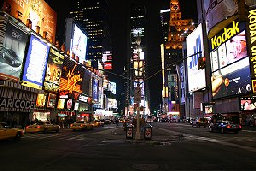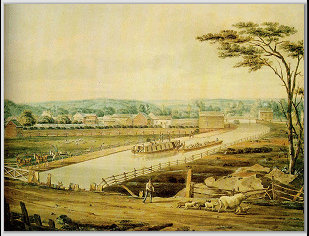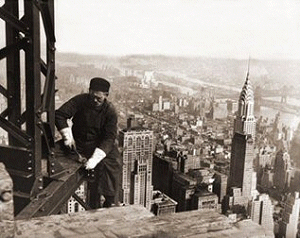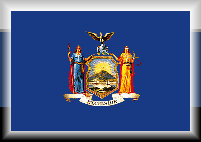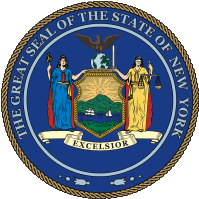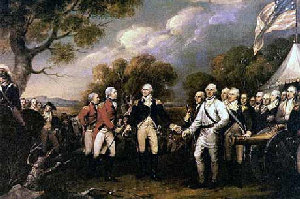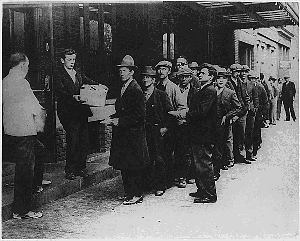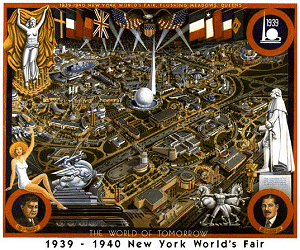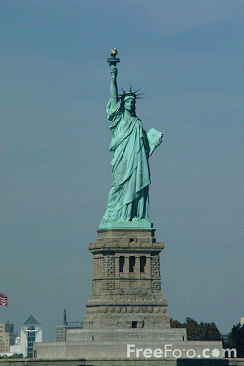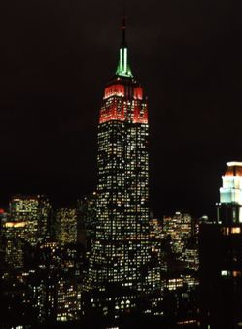Post War New York
The great expansion of New York began after the revolution. Many war participants were awarded land grants in the western part
of the state and so the colonization rapidly spread westward after the war.
Transportation was an immediate concern for these
new pioneers.
When a canal across New York State was first proposed by Jesse Hawley, a miller in the town of Geneva, President
Thomas Jefferson thought it was "little short of madness". Dewitt Clinton then mayor of New York City supported the idea. Clinton's
opponents called the proposal "Clinton's Folly". In 1817, after Clinton became governor of New York State, funds for a canal from
the Hudson River to the Great Lakes were quickly approved.
The
Erie Canal was finished in 1825. The canal opened up vast areas
of New York to commerce and settlement, and enabled port cities such as Buffalo to grow and prosper. With the completion of the
Welland
Canal in 1833, a waterway from the Atlantic Ocean to the great lakes was now realized. Much later in the 1950's, the St. Lawrence
Seaway further enhanced this waterborne transportation system to the Great Lakes.
In addition to the canal system, a railroad
link between the Atlantic and the Great Lakes seemed like a good idea to all involved (with the exception of the Erie Canal and barge
operators), and it was in pursuit of this dream that a group of investors from Jamestown received a charter in 1832 to build one.
The New York and Erie Railroad would be the longest railroad in the world at 483 miles, and it would pass through the Southern Tier
of the state. On board the inaugural run in 1851 were President Millard Fillmore, and Secretary of State Daniel Webster,
who reportedly rode in a rocking chair that had been affixed to a flat bed car--the better to view the scenery.
Although no civil war battles were fought in New York, thousands of New York volunteers readily joined the battle and fought for the
Union side. When
Abraham Lincoln called for 75,000 volunteers to join the military and fight for the Union, 8,000 from New York
City signed up within ten days. The war finally concluded at Gettysburg in neighboring Pennsylvania where it should be
noted that on that first day's battle at Gettysburg, of the six infantry divisions which fought that day, five were commanded by New
York generals, - Robinson, Doubleday, Wadsworth, Barlow, and Steinwehr.
As the war dragged on, a military manpower shortage occurred
and Congress passed the first conscription act in United States history on March 3, 1863. Anger at military conscription led
to the
Draft Riots of 1863, one of the worst incidents of civil unrest in American history. The riots were a series of violent disturbances
in New York City that were the culmination of discontent with the new conscription laws.
Post-Civil War New York was the nation's
most modern city. Even so, and despite a population of 900,000, it remained a comparatively provincial place, a small town exploding.
Only church steeples punctuated the skyline; the tallest, climbing 284 feet, belonged to Trinity Church at Wall Street and Broadway.
In
1869, New York's critical role in national life was cemented with the completion of the Union Pacific Railroad, making transcontinental
rail service possible for the first time.
In 1886,
The Statue of Liberty, a gift of France, was dedicated in New York Harbor.
Its famous inscription, "Give me your tired, your poor, your huddled masses yearning to breathe free," became a beacon to immigrants
from around the world.







This website was created and is maintained by:
Philip J. June
Tucson, AZ
This website was first created
and published on 12.02.07;
Last update was 12.02.07
The Erie Canal
Bread Line - Depression of 1929
1939 New York World's Fair
Finger Lakes Vineyards
Times Square - New York City
The following are some of the major Revolutionary War battles:
In September of 1781, the British at Yorktown, Virginia, under Lord Cornwallis, were beseiged by a
combined assault of French forces led by General
Comte de Rochambeau and American forces led by General George Washington.
The American force comprised some 10,000 French and 8,000 American regulars, against a British force of 8,000. As
the siege was conducted, 24 French warships commanded by French Admiral de Grasse kept the British from reinforcing Cornwallis.
The siege was successful and on October 19, 1781, Cornwallis surrendered. This was the last major engagement of the war.
Sporadic
fighting continued after the Yorktown surrender, and Washington believed the war might drag on
In London, as the loss at Yorktown
became known, political support for the war plummeted and Prime Minister Lord North resigned. In April 1782,
the Commons voted to end the war in America. The formal end of the war did not occur until the
Treaty of Paris was signed on
September 3,1783, and the United States Congress ratified the treaty on January 14, 1784.
The last British troops left New York City
on November 25, 1783. That same year, In New York City on December 4th, George Washington gave his farewell address to his officers.
In 1789 New York City was designated as the nations' capital and on April 30, 1789 George Washington was inaugurated as the nation's
first president.
The capital was moved to Philadelphia one year later, in 1790.
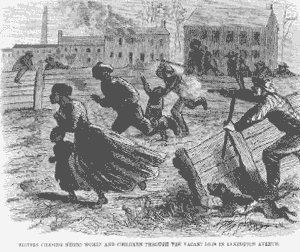
The 1863 Draft Riots
Construction of Empire State Building - 1930
Chrysler Building in Background
New York
The
Empire State
History of
Civil War Era
The 20th Century
New York City is famous for it's subways and the first subway was built in 1904, giving New Yorkers an alternate and quicker route
to where they were going. Seven years late Grand Central Terminal opened and became the world's largest train station.
The
Great
Depression, which was to affect the rest of the world, began with the
Stock Market Crash of 1929. The Depression was both a time of
unemployment and poverty, and a period of increased government involvement in the economy.
The Empire State Building in New York
City stood as the
world's tallest building for more than forty years, from its completion in 1931 until the construction of the World
Trade Center North Tower topped out on December 23, 1970. The building's distinctive art deco spire was originally designed
to be a mooring mast and depot for dirigibles. The 102nd floor was originally a landing platform with a dirigible gangplank.
The
1939 New York World's Fair, marking the 150th anniversary of George Washington's inauguration in Federal Hall, was a high point of
technological optimism, meant to mark the end of the Depression.
The United Nations was founded in 1945 to replace the
League
of Nations, in the hope that it would intervene in conflicts between nations and thereby avoid war. The United Nations headquarters
was built on an 18 acre site in New York City purchased with a donation to the UN by John D. Rockefeller, Jr. in 1946. Although it
is in New York City, the land occupied by the United Nations headquarters is international territory.
New Yorkers will never
forget the Great Northeast Blackout of 1965, when a massive, cascading power failure darkened the entire Northeast and parts of Canada
for up to 25 hours in some places.
New York Today
New York's gross state product in 2006 was $1.02 trillion, ranking third in size behind the larger states of California and Texas.
New
York City is the financial and commerce capital of the United States and the world.
The state ranks seventh in the nation
in manufacturing, with 586,400 employees in 2005. The principal industries are printing and publishing, industrial machinery and equipment,
electronic equipment, and instruments. The convention and tourist business is also an important source of income.
The
Finger
Lakes region has orchards producing apples, one of New York's leading crops; vineyards here and on Long Island make the state famous
for its wines. The state produces other, diverse crops, especially grapes, strawberries, cherries, pears, onions, and potatoes; maple
syrup is extracted, and New York is the third leading U.S. producer of dairy goods. New York's mineral resources include crushed stone,
cement, salt, and zinc.
Burgoyne Surrenders at Saratoga
The Erie Canal








